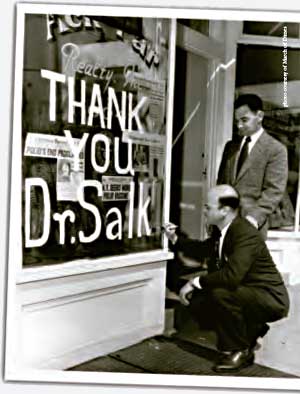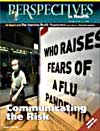
The Man Who Made Polio History(Page 3)Following that historic day, the Salk vaccine quickly became part of the pediatrician's arsenal against childhood diseases. More than 450 million doses were administered in the vaccine's first four years. Promoted by the March of Dimes, Salk became an overnight celebrity, with appearances in national magazines such as Life and Time and on radio and television shows. But his celebrity earned Salk the ire of his fellow researchers, most notably Sabin. Headline grabbing, in those less media-dominated times, was considered bad form in the scientific community. In 1960, Sabin announced his successful development of a new oral polio vaccine (OPV). Like many traditional vaccines, it used a weakened form of the virus to establish a harmless infection in patients, thus providing immunity to any future exposures. Dropped onto sugar cubes or mixed into a sweet syrup, Sabin's vaccine was swallowed rather than injected. Soon after its introduction in 1962, the United States—and indeed, most national immunization programs—adopted the oral vaccine. In the meantime, the Salk vaccine had saved more than 35,000 people from death or disability, according to 1958 estimates of the U.S. Public Health Service. The debate over which of the two vaccines is better has continued since their introduction and is still not fully resolved. Today, both vaccines are in wide use, and both have played important roles in the global fight against polio. A global goalAt its peak, polio paralyzed or killed up to 500,000 people worldwide every year. Today, children from developed nations are more likely to be struck by lightning than to contract polio. But in a handful of developing nations, the combination of poverty, overcrowding, and poor sanitation continues to provide a fertile breeding ground for polioviruses. Malnourished, impoverished children with limited access to basic health care are the most at risk.  In 1985, the Pan American Health Organization (PAHO) launched an initiative to eradicate polio from the Western Hemisphere by the year 2000. Three years later, the World Health Organization (WHO) decided to build a global effort on the PAHO model. Together with Rotary International, UNICEF, and the U.S. Centers for Disease Control and Prevention, WHO launched the Global Polio Eradication Initiative, with the goal of certifying the world polio-free by the year 2000. The effort came close. After the Americas were certified polio-free in 1994, the Western Pacific region followed in 2000, and Europe in 2002. Despite setbacks to these efforts in the last two years (during which the virus has reappeared in 16 countries that were previously polio-free), polio is well on its way to becoming only the second disease, after smallpox, to achieve global eradication. Cases have plummeted by 99 percent (from 350,000 in 1988 to 784 in 2003). Polio, once feared around the world, is now endemic in only six countries—Afghanistan, Egypt, India, Niger, Nigeria, and Pakistan. Supporters credit this success to the global campaign of immunizing every child with Sabin's oral polio vaccine. Endemic countries have hosted National Immunization Days (NIDs) to reach their goal. During these three- to four-day events, volunteers load up plastic or Styrofoam "cold boxes" to preserve the vaccine, and travel by car, boat, motorcycle, and foot with the goal of vaccinating every child under 5, no matter how remote the location. They have been largely successful. Over the last 15 years, UNICEF has provided enough OPV to vaccinate more than 2 billion children. Last year alone, India boasted that 165 million of its children were vaccinated in just three days.
|
Articles: The Man Who Made Polio History Mothers and Children: Make Them Count Columns: Last Word For Printing: |
